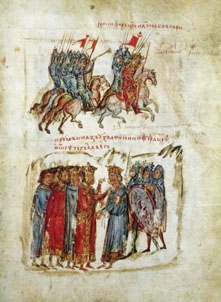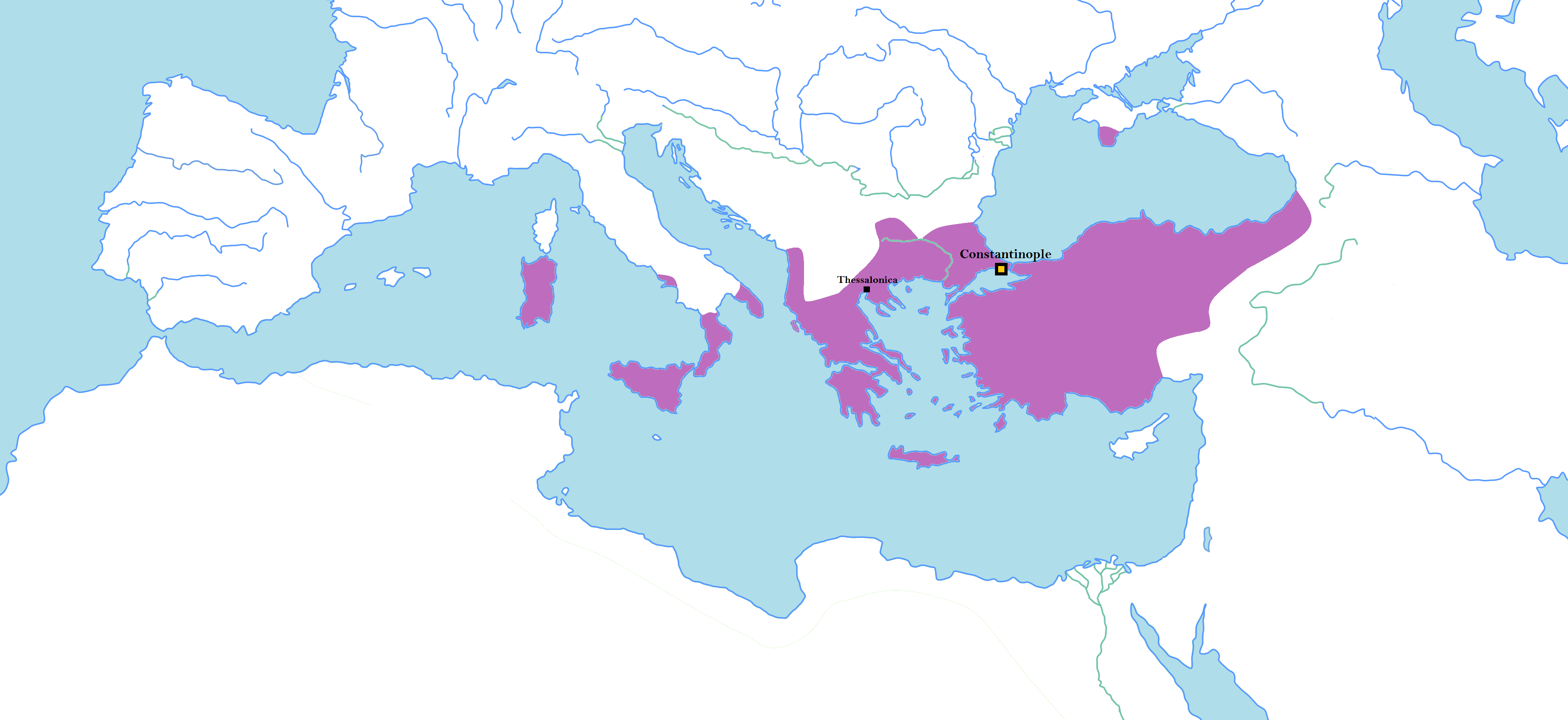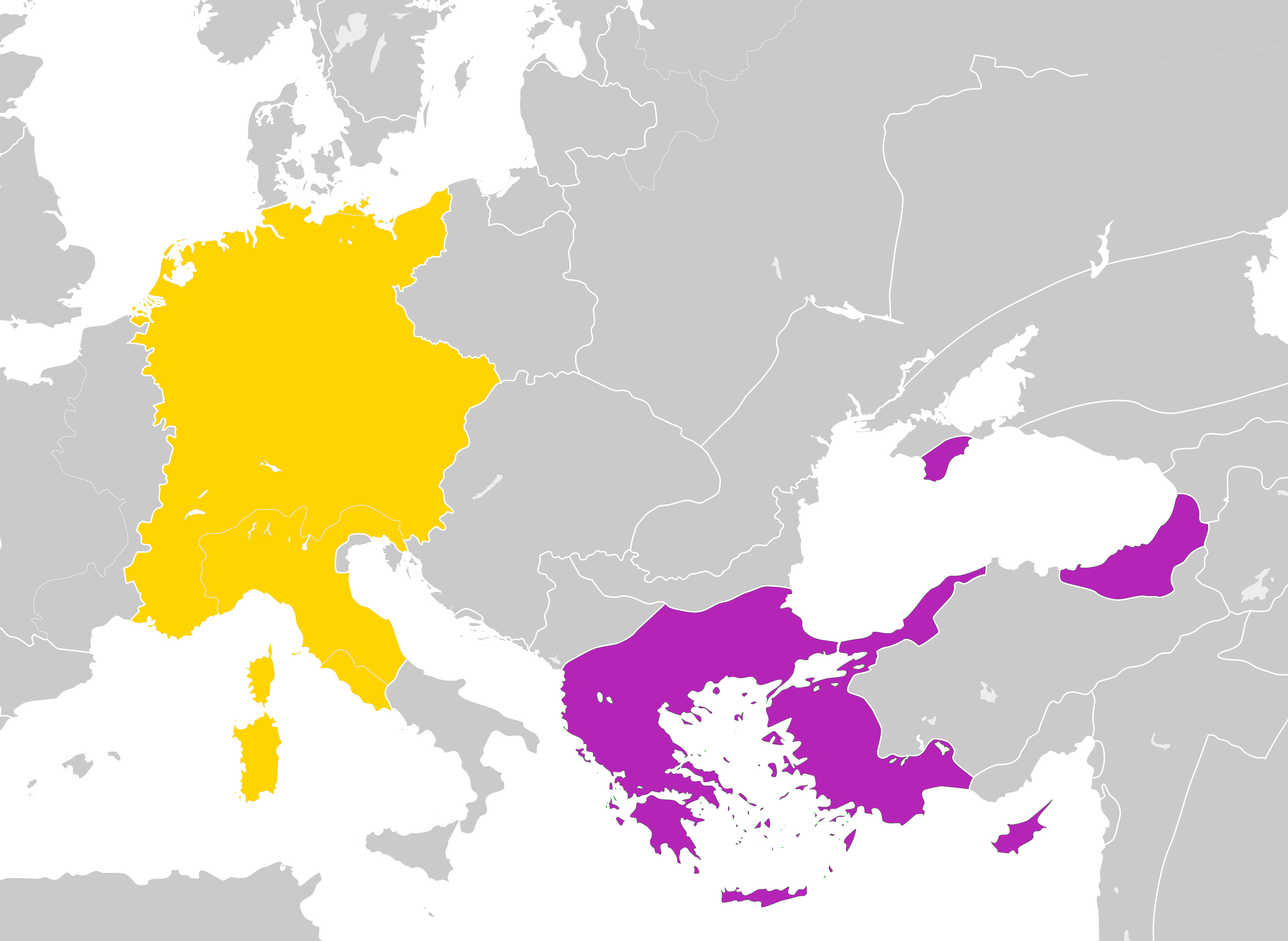|
Stauracius
Staurakios or Stauracius ( gr, Σταυράκιος, links=no; early 790s – 11 January 812AD) was Byzantine emperor from 26 July to 2 October 811. He was born in the early 790s, probably between 791 and 793, to Nikephoros I and an unknown woman. Nikephoros seized the throne of the Byzantine Empire from Empress Irene in 802, and elevated Staurakios to co-emperor on 25 December 803. On 20 December 807, a bride show was held by Nikephoros to select a wife for Staurakios, which resulted in his marriage to Theophano of Athens, a kinswoman of Irene. Little else is known of him until he came to take the throne upon the death of Nikephroros. Staurakios took part in an invasion of the Bulgarian Khanate in 811, alongside his father and brother-in-law. Although initially successful, with the Byzantines laying siege to the Bulgarian capital of Pliska and defeating a relief force, they were soon ambushed by Khan Krum, and trapped in a small valley. The Bulgarians then attacked, startin ... [...More Info...] [...Related Items...] OR: [Wikipedia] [Google] [Baidu] |
Battle Of Pliska
The Battle of Pliska or Battle of Vărbitsa Pass was a series of battles between troops, gathered from all parts of the Byzantine Empire, led by the Emperor Nicephorus I, and the First Bulgarian Empire, governed by Khan Krum. The Byzantines plundered and burned the Bulgar capital Pliska which gave time for the Bulgarians to block passes in the Balkan Mountains that served as exits out of Bulgaria. The final battle took place on 26 July 811, in some of the passes in the eastern part of the Balkans, most probably the Vărbitsa Pass. There, the Bulgarians used the tactics of ambush and surprise night attacks to effectively trap and immobilize the Byzantine army, thus annihilating almost the whole army, including the Emperor. After the battle, Krum encased the skull of Nicephorus in silver, and used it as a cup for drinking. This is one of the most documented instances of the custom of the skull cup. The Battle of Pliska was one of the worst defeats in Byzantine history. It dete ... [...More Info...] [...Related Items...] OR: [Wikipedia] [Google] [Baidu] |
Nikephoros I
Nikephoros I or Nicephorus I ( gr, Νικηφόρος; 750 – 26 July 811) was Byzantine emperor from 802 to 811. Having served Empress Irene as '' genikos logothetēs'', he subsequently ousted her from power and took the throne himself. In reference to his career before becoming emperor, he is sometimes surnamed "the Logothete" (ὁ Λογοθέτης) and "Genikos" or "Genicus" (ὁ Γενικός). Nikephoros pursued wars against the Arabs and Bulgarians, with mixed results; while invading Bulgaria he was defeated and killed at the Battle of Pliska. Background Sources outside the Byzantine context, including Michael the Syrian, al-Tabari, and Mas'udi, preserve the tradition that Nikephoros was of Ghassanid Arab origin. al-Tabari claims that he derived this information from Byzantine sources, but no surviving Byzantine chronicle makes explicit mention of the emperor's ethnic background. The modern scholar Paul Julius Alexander suggests that al-Tabari did transmit informat ... [...More Info...] [...Related Items...] OR: [Wikipedia] [Google] [Baidu] |
Theophano Of Athens
Theophano ( gr, Θεοφανώ; died after 811) was the Empress consort of Staurakios of the Byzantine Empire. According to the chronicle of Theophanes the Confessor, Theophano was a relative of Irene (reigned 797–802). Both women were from Athens but the nature of their relation to each other is not known. On 20 December 807, Theophano married Staurakios. The date of their marriage was recorded by Theophanes. Staurakios was the only known son of Nikephoros I. He was co-emperor with his father since 803. Theophano had been betrothed to another man but took place in the imperial bride-show. She was possibly chosen to legitimise the connection of the new dynasty to their predecessor. Her father-in-law is presumed to have been a widower by the time he was elevated to the throne. In the absence of a senior empress, Theophano was the only Empress during his reign. On 26 July 811, Nikephoros was killed while fighting against Krum of Bulgaria at the Battle of Pliska. Much of the Byzant ... [...More Info...] [...Related Items...] OR: [Wikipedia] [Google] [Baidu] |
List Of Byzantine Emperors
This is a list of the Byzantine emperors from the foundation of Constantinople in 330 AD, which marks the conventional start of the Eastern Roman Empire, to its fall to the Ottoman Empire in 1453 AD. Only the emperors who were recognized as legitimate rulers and exercised sovereign authority are included, to the exclusion of junior co-emperors (''symbasileis'') who never attained the status of sole or senior ruler, as well as of the various usurpers or rebels who claimed the imperial title. The following list starts with Constantine the Great, the first Christian emperor, who rebuilt the city of Byzantium as an imperial capital, Constantinople, and who was regarded by the later emperors as the model ruler. It was under Constantine that the major characteristics of what is considered the Byzantine state emerged: a Roman polity centered at Constantinople and culturally dominated by the Greek East, with Christianity as the state religion. The Byzantine Empire was the direct lega ... [...More Info...] [...Related Items...] OR: [Wikipedia] [Google] [Baidu] |
Leo III (pope)
Pope Leo III (died 12 June 816) was bishop of Rome and ruler of the Papal States from 26 December 795 to his death. Protected by Charlemagne from the supporters of his predecessor, Adrian I, Leo subsequently strengthened Charlemagne, Charlemagne's position by crowning him Carolingian Empire, emperor. The coronation was not approved by most people in Constantinople, although the Byzantines, occupied with their own defenses, were in no position to offer much opposition to it. Rise According to the ''Liber Pontificalis'', Leo was "of the Roman people, Roman nation, the son of Atzuppius" (''natione romanus ex patre Atzuppio''). The ''Chronicon Anianense'' says, more specifically, that he was "born in Rome to Asupius and Elizabeth" (''natus rome ex patre asupio matre helisabeth''). Usually considered to be of Greeks, Greek origin, his father's name may suggest an Arab background.T. F. X. Noble (1985), The Declining Knowledge of Greek in Eighth- and Ninth-Century Papal Rome", ''Byzantin ... [...More Info...] [...Related Items...] OR: [Wikipedia] [Google] [Baidu] |
Logothetēs Tou Genikou
The ( gr, λογοθέτης τοῦ γενικοῦ, often called or simply (, 'the general ogothete), and usually rendered in English as the General Logothete, was in charge of the 'general financial ministry', the of the middle Byzantine Empire.. History and functions The was responsible for general taxation and revenue, and also served as a court for financial cases. As such, it broadly fulfilled the tasks of the earlier , although it was mostly derived from the "general department" of the praetorian prefecture. The first attested , the monk Theodotos, is mentioned in 692, but the post may have been instituted as early as 626. The bureau of the and its logothete remained one of the chief ministries for the entire middle Byzantine period (7th–12th centuries). During the Komnenian period, its importance declined, but recovered under the Angeloi. Following the sack of Constantinople in 1204 and the dissolution of the Byzantine Empire, the office of the was retained a ... [...More Info...] [...Related Items...] OR: [Wikipedia] [Google] [Baidu] |
Charlemagne
Charlemagne ( , ) or Charles the Great ( la, Carolus Magnus; german: Karl der Große; 2 April 747 – 28 January 814), a member of the Carolingian dynasty, was King of the Franks from 768, King of the Lombards from 774, and the first Holy Roman Emperor, Emperor of the Romans from 800. Charlemagne succeeded in uniting the majority of Western Europe, western and central Europe and was the first recognized emperor to rule from western Europe after the fall of the Western Roman Empire around three centuries earlier. The expanded Frankish state that Charlemagne founded was the Carolingian Empire. He was Canonization, canonized by Antipope Paschal III—an act later treated as invalid—and he is now regarded by some as Beatification, beatified (which is a step on the path to sainthood) in the Catholic Church. Charlemagne was the eldest son of Pepin the Short and Bertrada of Laon. He was born before their Marriage in the Catholic Church, canonical marriage. He became king of the ... [...More Info...] [...Related Items...] OR: [Wikipedia] [Google] [Baidu] |
Coronation Of The Holy Roman Emperor
The Coronation of the Holy Roman Emperor was a ceremony in which the ruler of Western Europe's then-largest political entity received the Imperial Regalia from the hands of the Pope, symbolizing both the pope's right to crown Christian sovereigns and also the emperor's role as protector of the Roman Catholic Church. The Holy Roman Empresses were crowned as well. The Holy Roman Empire was established in the year 800 under Charlemagne. Later emperors were crowned by the pope or other Catholic bishops. Charles V became the last Holy Roman Emperor to be crowned by a pope: Clement VII in Bologna in 1530. Thereafter, until the abolition of the empire in 1806, no further crownings by the Pope were held.See also Guy Stair SaintyThe Holy Roman Empire: Introduction. From thAlmanach de la Courwebsite. Retrieved on 14 September 2008. Later rulers simply proclaimed themselves ''Imperator Electus Romanorum'' or "Elected Emperor of the Romans" after their election by the princes and coronation as ... [...More Info...] [...Related Items...] OR: [Wikipedia] [Google] [Baidu] |
Pope
The pope ( la, papa, from el, πάππας, translit=pappas, 'father'), also known as supreme pontiff ( or ), Roman pontiff () or sovereign pontiff, is the bishop of Rome (or historically the patriarch of Rome), head of the worldwide Catholic Church, and has also served as the head of state or sovereign of the Papal States and later the Vatican City State since the eighth century. From a Catholic viewpoint, the primacy of the bishop of Rome is largely derived from his role as the apostolic successor to Saint Peter, to whom primacy was conferred by Jesus, who gave Peter the Keys of Heaven and the powers of "binding and loosing", naming him as the "rock" upon which the Church would be built. The current pope is Francis, who was elected on 13 March 2013. While his office is called the papacy, the jurisdiction of the episcopal see is called the Holy See. It is the Holy See that is the sovereign entity by international law headquartered in the distinctively independent Vatic ... [...More Info...] [...Related Items...] OR: [Wikipedia] [Google] [Baidu] |
Warren Treadgold
Warren T. Treadgold (born April 30, 1949, Oxford, England) is an American historian and specialist in Byzantine studies. He is the National Endowment for the Humanities Professor of Byzantine Studies at Saint Louis University. His interest in the political, economic, military, social, and cultural history of the Byzantine Empire extends to the Byzantine historians themselves. Treadgold has also taught at UCLA, Stanford, Hillsdale, Berkeley, and Florida International University. He is married since September 25, 1982 to Irina Andreescu-Treadgold. Education Treadgold holds an AB from Harvard University (1970) and a PhD from the same university (1977). Books * ''The University We Need: Reforming America’s Higher Education'' (New York: Encounter Books, 2018); * ''The Middle Byzantine Historians'' (New York: Palgrave Macmillan, 2013); * ''The Early Byzantine Historians'' (New York: Palgrave Macmillan, 2007); * ''A Concise History of Byzantium'' (New York: Palgrave Macmillan, 2001 ... [...More Info...] [...Related Items...] OR: [Wikipedia] [Google] [Baidu] |
Problem Of Two Emperors
The problem of two emperors or two-emperors problem (deriving from the German term ''Zweikaiserproblem'')The term was introduced in the first major treatise on the issue, by W. Ohnsorge, cf. . is the historiographical term for the historical contradiction between the idea of the universal empire, that there was only ever one true emperor at any one given time, and the truth that there were often multiple individuals who claimed the position simultaneously. The term is primarily used in regards to medieval European history and often refers to in particular the long-lasting dispute between the Byzantine emperors in Constantinople and the Holy Roman emperors in modern-day Germany and Austria as to which monarch represented the legitimate Roman emperor. In the view of medieval Christians, the Roman Empire was indivisible and its emperor held a somewhat hegemonic position even over Christians who did not live within the formal borders of the empire. Since the collapse of the Western R ... [...More Info...] [...Related Items...] OR: [Wikipedia] [Google] [Baidu] |
Strategos
''Strategos'', plural ''strategoi'', Linguistic Latinisation, Latinized ''strategus'', ( el, στρατηγός, pl. στρατηγοί; Doric Greek: στραταγός, ''stratagos''; meaning "army leader") is used in Greek language, Greek to mean military General officer, general. In the Hellenistic world and the Byzantine Empire, Eastern Roman Empire the term was also used to describe a military governor. In the modern Hellenic Army, it is the highest officer rank. Etymology ''Strategos'' is a compound of two Greek words: ''stratos'' and ''agos''. ''Stratos'' (στρατός) means "army", literally "that which is spread out", coming from the proto-Indo-European root *stere- "to spread". ''Agos'' (ἀγός) means "leader", from ''agein'' (ἄγειν) "to lead", from the proto-Ιndo-Εuropean root *ag- "to drive, draw out or forth, move”. Classical Greece Athens In its most famous attestation, in Classical Athens, the office of ''strategos'' existed already in the ... [...More Info...] [...Related Items...] OR: [Wikipedia] [Google] [Baidu] |










